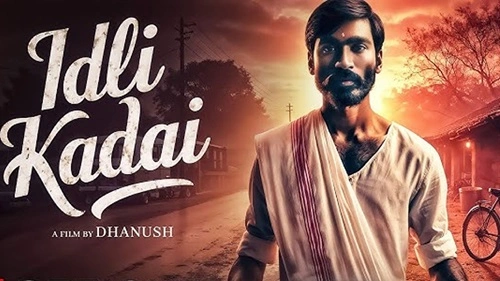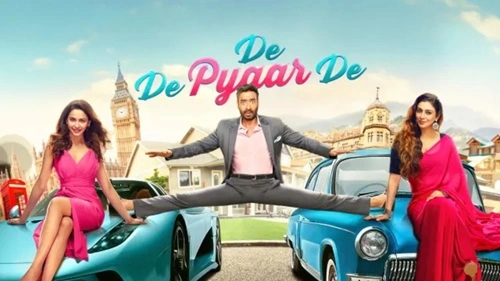Uttar Pradesh is known for its rich cultural heritage, historical significance, and vibrant traditions. Dance and music form an integral part of the state’s cultural identity, with various folk and classical dance forms reflecting the diverse traditions of its people.
The traditional dances of Uttar Pradesh are deeply rooted in history, mythology, and social customs. They are performed during festivals, religious celebrations, and special occasions, showcasing the state’s artistic diversity. From the graceful Kathak to the energetic Charkula dance, each dance form tells a unique story.
Let’s explore some of the most famous traditional dance forms of Uttar Pradesh.
1. Kathak – The Classical Dance of Uttar Pradesh
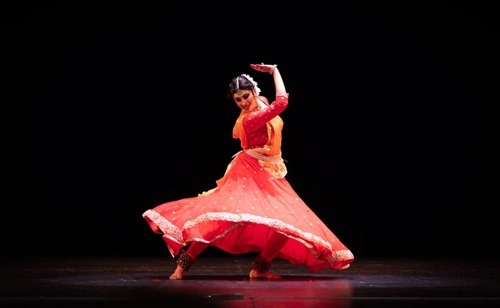
Kathak, one of the eight classical dance forms of India, originated in Uttar Pradesh. It is known for its intricate footwork, graceful hand movements, and expressive storytelling.
Significance:
Kathak traces its roots to the ancient storytelling tradition of Katha Vachaks, or storytellers, who narrated mythological tales through dance. Over time, it evolved into a refined art form under the patronage of Mughal rulers, incorporating Persian and Islamic influences.
The dance is performed in three main styles: Lucknow Gharana, Banaras Gharana, and Jaipur Gharana. The Lucknow Gharana, which developed in the Nawabi courts of Awadh, is particularly famous for its emphasis on grace and expression.
2. Raslila – The Divine Dance of Lord Krishna
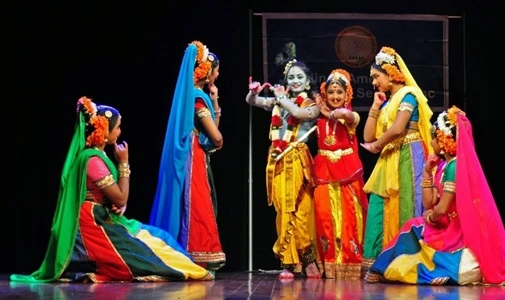
Raslila is a devotional dance that depicts the divine love between Lord Krishna and the Gopis of Vrindavan. It is performed in Mathura, Vrindavan, and other parts of Braj during Janmashtami and Holi.
Significance:
Raslila is considered a form of Bhakti (devotional) dance, symbolizing the eternal bond between the devotee and the divine. The performances include singing, dancing, and enactment of episodes from Krishna’s life, making it a spiritual and theatrical experience.
The performers, often young boys dressed as Krishna and Radha, move gracefully in circular patterns, accompanied by devotional music and bhajans.
3. Charkula Dance – The Dance of Fire and Balance
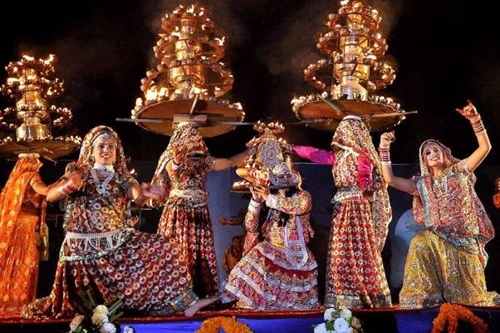
Charkula is a unique and dramatic folk dance performed in the Braj region of Uttar Pradesh. The highlight of this dance is women balancing large, multi-tiered oil lamps (charkula) on their heads while dancing gracefully.
Significance:
According to legend, Charkula dance is associated with Radha’s birth and is performed in her honor. It is particularly popular during Krishna-related festivals in Mathura and Vrindavan.
The dancers wear traditional attire, and their synchronized movements, combined with the flickering lamps, create a mesmerizing visual effect.
4. Ramlila – The Theatrical Dance-Drama
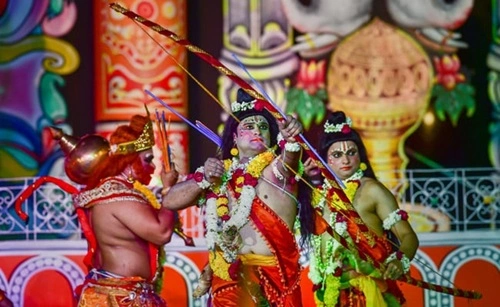
Ramlila is a dramatic folk dance that narrates the story of Lord Rama’s life, based on the Ramayana. It is performed in various towns and villages of Uttar Pradesh, especially during Navratri and Dussehra.
Significance:
Ramlila performances, especially in Ayodhya, Varanasi, and Ramnagar, are famous for their grand scale and elaborate sets. The dance-drama features beautifully choreographed sequences, devotional music, and vibrant costumes.
The most famous Ramnagar Ramlila in Varanasi has been performed for over 200 years and attracts thousands of spectators every year.
5. Nautanki – The Folk Theatre Dance
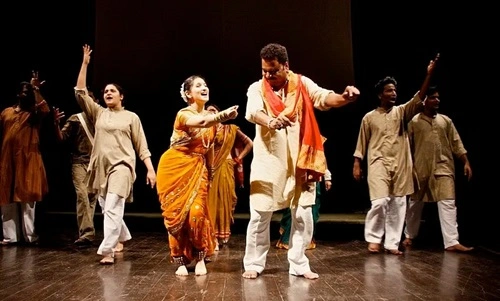
Nautanki is a traditional folk theatre form that combines music, dance, and storytelling. It was once the most popular form of entertainment in rural Uttar Pradesh.
Significance:
Nautanki performances narrate historical, mythological, and social stories with a blend of humor and drama. The dancers wear colorful costumes and perform lively dance movements to the beats of dholak, harmonium, and tabla.
Despite modern entertainment taking over, efforts are being made to revive this traditional art form in rural areas.
6. Kajri Dance – The Dance of Monsoon Festivals
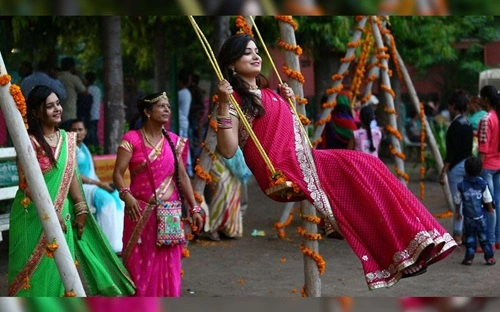
Kajri is a folk dance performed mainly by women during the monsoon season in eastern Uttar Pradesh, particularly in Mirzapur and Varanasi. It is accompanied by Kajri songs, which express the emotions of longing and romance.
Significance:
Kajri dance reflects the joy of the rainy season and the emotions of women whose husbands are away from home. It is performed during Shravan (monsoon month) and is an important part of Teej and Kajari Teej festivals.
7. Jhora Dance – The Dance of Unity
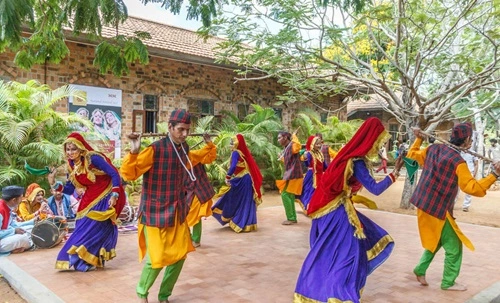
Jhora is a group folk dance performed in the Bundelkhand region of Uttar Pradesh. It is mainly performed by men and women during community celebrations, fairs, and weddings.
Significance:
Dancers form a circle, holding hands, and move in synchronized steps to the rhythm of folk songs. The dance signifies harmony and togetherness, breaking social barriers.
8. Swang – The Dramatic Dance of Satire
Swang is a traditional folk dance-drama that combines dance, music, and humor to convey social messages. It is popular in western Uttar Pradesh and Haryana.
Significance:
Swang performances use exaggerated movements and dialogues to entertain and educate the audience on social and moral issues. It is often performed in open-air theaters during festivals and village fairs.
9. Dhobiya Dance – The Folk Dance of Washermen Community
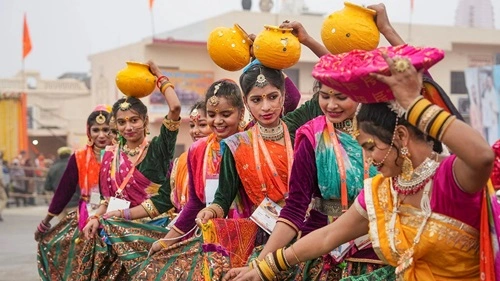
Dhobiya dance is performed by the Dhobi (washermen) community of Uttar Pradesh, particularly in eastern Uttar Pradesh and Bihar.
Significance:
The dance is an expression of joy and is performed during weddings and community gatherings. It includes rhythmic clapping, foot-stamping, and lively folk songs.
10. Alha-Udal Dance – The Warrior Dance of Bundelkhand
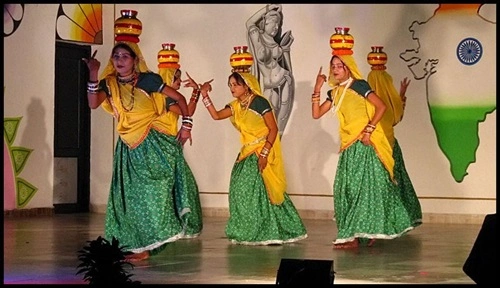
Alha-Udal dance is based on the Alha-Khand ballads, which narrate the bravery of the legendary warriors Alha and Udal of Bundelkhand.
Significance:
The dance is performed during fairs and religious festivals in Jhansi, Banda, and Chitrakoot. Dancers enact battle scenes with mock fights using swords and shields, celebrating the region’s warrior tradition.
Conclusion
The traditional dances of Uttar Pradesh showcase the state’s deep-rooted cultural and spiritual heritage. From the graceful Kathak and devotional Raslila to the energetic Charkula and theatrical Ramlila, each dance form represents the emotions, beliefs, and traditions of the people.
These dances continue to thrive through festivals, cultural events, and government initiatives promoting folk art. In an era of modernization, it is essential to preserve and celebrate these age-old traditions, ensuring that future generations experience the vibrant cultural heritage of Uttar Pradesh.
Whether performed in grand temples, village courtyards, or open-air theaters, the traditional dances of Uttar Pradesh remain a living legacy of India’s artistic and spiritual traditions.
